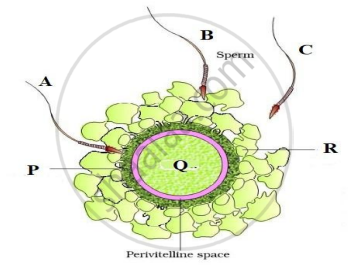Advertisements
Advertisements
प्रश्न
The figure given below shows 3 sperms A, B and C.
- Which one of the three sperms will gain entry into the ovum?
- Describe the associated changes induced by it on P and Q.

Ovum surrounded by few sperms
उत्तर
- Sperm A
- In the figure given, Sperm ‘A' has come in contact with the zona pellucida layer (P) of the ovum (Q), which will induce changes in the membrane that will block the entry of additional sperms (B and C). Thus, it ensures that only one sperm can fertilise the ovum.
The secretions of the acrosome of sperm A will help it to enter into the cytoplasm of the ovum (Q) through the zona pellucid (P) and the plasma membrane, this will induce the completion of the meiotic division of the secondary oocyte (Q).
The second meiotic division in Q being unequal will result in the formation of a second polar body and a haploid ovum. Then, the haploid nucleus of sperm ‘A’ and that of the ovum (Q) will fuse together to form a diploid zygote.
APPEARS IN
संबंधित प्रश्न
The zygote divides to form __________ which is implanted in uterus.
Name the hormones secreted and write their functions by corpus luteum and placenta (any two).
Name the stages in a human female where Corpus luteum and placenta co-exist.
Explain the process of implantation.
Morula is a developmental stage ______.
Termination of gastrulation is indicated by ______.
A change in the amount of yolk and its distribution in the egg will affect ______.
The solid mass of 8-16 cells formed from zygote after successive mitotic divisions is called ______.
Read the following and answer from given below:
Cleavage is the series of rapid mitotic divisions in the zygote and forms blastula. The 2, 4, 8, 16 daughter cells are called blastomeres. An embryo with 64 blastomeres is known as a blastocyst and has a blastocoel cavity. Blastocyst gets implanted in the uterine wall and leads to pregnancy.
The Site of implantation is ______
How does zona pellucida of ovum help in preventing polyspermy?
